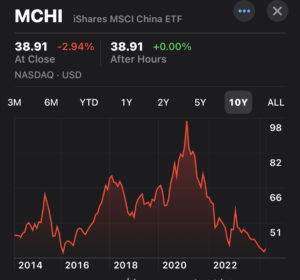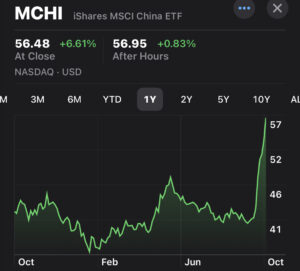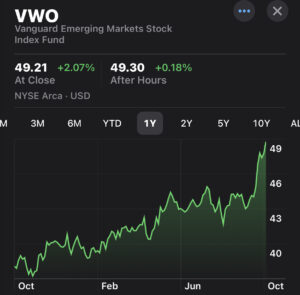A phoenix moment
This is to follow up on an earlier story from February; in Antibubble I expressed skepticism that China had become “uninvestable”. I reiterated this view in June: https://financology.net/2024/05/31/market-update-3/#comment-3708
It was hard to find any reason to own Chinese stocks. That alone however is a good reason to take a closer look, because when the investment case is obvious, the price tends to reflect it, neutralizing much of the benefit. The best opportunities arise when the crowd is either afraid or apathetic.
Here’s how it looked at the time:

Here’s how it looks now:

My preferred broader approach has been not quite as spectacular, but a bit smoother ride:

It’s less than impressive that the latest rally isn’t organic, but driven by neokeynesian stimulus. Chinese central planners have so far been restrained in the application of the kind of artificial boosters that have undermined western economies, but may have reached their limit.
All things considered I still think there is a long term case for Chinese stocks, but the original justification is no longer as compelling. As the charts indicate, prices have risen some 45%. Bloomberg reports:
China’s Sudden Stock Rally Sucks Money From Rest of Asia
As the article opines, valuations are still attractive. But the level of buying excitement is a caution flag, and the price trajectory smacks of too far too fast to be sustainable. However the remark may have been intended, “Everyone is doing so.” is not a bonus. No more than everyone staying the heck away was a minus. It’s become quite overbought on a short term basis, as is obvious from the second chart above. I remain modestly overweight in the context of a diversified portfolio. The near term is a crap shoot; it could continue to rip but anything this hot can also burn your fingers.
My caution is now being vindicated as EMs in general and China in particular have sold off sharply. This relieves some of my concerns about the rally having gone too far too fast and restores some lost appeal.
There could be more downside where this came from, but at this point the longer term potential again begins to overwhelm the shorter term risk.
Commodities have also sold off sharply after a spirited rally. For investors looking for longer term inflation protection, they too have regained appeal.
This selloff is partly due to dollars recovering from an oversold position. Even if it extends near term, the US fiscal situation almost assures dollars will resume their decline. Such an environment calls into question one dimensional characterizations of stocks and commodities as “risk assets” … for investors who regard inflation as their main risk they are “risk off” assets.
The main nearer term concern is the ongoing unwind of the yield curve inversion. This represents a disinflationary overlay to the longer term inflationary outlook and suggests a temporary overweight to USD and UST to be opportunistically redeployed to stocks and commodities should they go on sale.